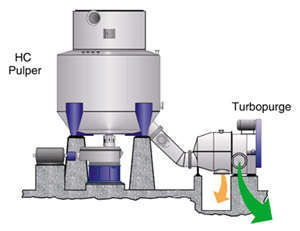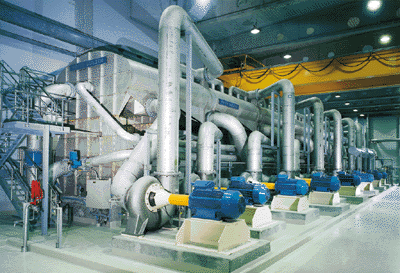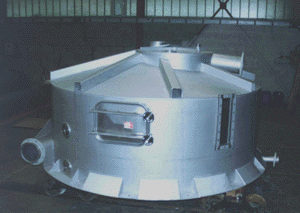|
The ever-increasing popularity of deinked pulp across the globe is spurring suppliers on to more product innovationp
By Rhiannon James
Sorting out the latest DIP news
Being a deinking equipment supplier to the paper industry would not appear to be too bad a line of business at the moment. With more and more paper mills opting to use deinked pulp (DIP) as their raw material source, suppliers find themselves in a fortunate position. Admittedly, companies are trimming back their investment budgets and less money is being thrown at new facilities, but this does not mean to say that investments have come to a complete standstill.

Figure 1 - The New High Consistency Pulper at Lang’s Ettringen mill
While new deinking plants may be few and far between in Europe and North America, paper companies are still upgrading their old equipment. On top of that, Asian and Latin American producers are racing ahead with plans to install brand new plants.
The number of new products that major suppliers have launched over the last 12 months also points to a fast moving and growing market. But the products covered in this article are just the tip of the iceberg. Many of the major suppliers also plan to unveil even more new equipment at the PTS Deinking Symposium this month in Munich, Germany.
Lang in the limelight
Over the past few months, technical articles on any part of the paper machine have not been complete without a reference to Lang's new PM 5 project in Ettringen, Germany. This time, though, it is the deinking system that is hogging the limelight. Even though the new 280,000 ton/yr newsprint and supercalendered PM started up in the fourth quarter of 1999, the new deinking plant will not start up until October this year.
In the meantime, Lang has been using PM 3's raw material line. According to the manager of the Ettringen site, Claus Palm, Lang will restart the mothballed PM 3 once the new DIP plant starts up.
A number of suppliers are working on the DIP project, including Voith Sulzer. The company is due to deliver a flotation plant to the mill in June 2000. The order includes a new EcoCell unit with an accepts capacity of up to 1,000 tons/day. According to the supplier, the Lang order fits in with the industry trend toward operating larger stock preparation systems in one line in a bid to find costs savings. Parallel lines are no longer needed, which cuts the cost of investing in a second set of pumps, piping and control equipment.
Kvaerner landed the job of supplying the new pulper for the plant. The pulper will have a capacity of 1,000 air-dried tons/day, with an operating volume of 115 m. Kvaerner is hailing the unit as the largest of its kind in the world. According to the supplier, the main features of the pulper are its high ink detachment and low sticky degradation, as well as its drives system and low power consumption.
Andritz was awarded the contract to supply the complete dewatering and bleaching equipment for the new 700 ton/day compact deinking plant at Lang. This order includes two disc filters, three pulp screw presses (see Box 3), a bleaching tower and two lines for sludge dewatering (with two gravity tables and two screw presses).
FMW is to deliver a turnkey Euro 5.4 million ($5.4 million) wastepaper storage feeding system and pulper feeding plant as part of the project. The feeding plant will supply three pulpers at the site and has a capacity of 2,000 tons/day.
New horizons
The Lang project is one of the few new projects being carried out in Europe at the moment and the situation is much the same across the Atlantic. As Mark Gilkey, market manager for deinking at Thermo Black Clawson, sees it, most of the new deinking action is likely to be seen in Asia in the next few years. "In terms of general trends in North America, most of the activity seems to be upgrades or expansions of existing systems. There are a few greenfield projects, but the activity level isn't nearly as strong for complete new systems as it was in the early 1990s," he explains. "In China though, which we also cover through our TBC China offices in Beijing and Guangzhou, there is a large amount of activity for new systems, especially in newsprint and liner systems for board mills. We've sold four deinking systems just in the past few months in China."
One such system is the new deinking plant at Sun Paper in the Shandong Province. In November last year, the mill started up a 100 ton/day deinking system from Thermo Black Clawson. The system is designed to deink sorted mixed office waste (MOW) to produce top liner. Before installing the deinking system, Sun Paper used bleached softwood kraft pulp, mainy imported from Canada or Chile. With the addition of the new line, the mill has increased the recycled content of its top liner to 80%. According to the supplier, the mill has reported no problems with stickies or dirt specks in the top ply.

Voith Sulzer installed a new disperger at Chapelle Darblay
| UPK-Kymmene invests in DIP duo |
| UPM-Kymmene is one of the many producers that have recently opted to increase DIP production at its paper plants. Over the last two years, the company has been particularly busy installing new systems at its Chapelle Darblay plant in France and the Shotton Paper mill i dispergerVoith Sulzer was involved in the French project, delivering a new flotation plant to the mill which produces newsprint from old newspapers and magazines. Last year, the new plant hit a production record of 720 tons/day of accepts in a single line.
The new DIP plant doubled the mill's deinking capacity from 175,000 tons/yr to 350,000 tons/yr and turned Chapelle Darblay into the first newsprint mill in the UPM-Kymmene group to run on 100% recycled materials. The Voith Sulzer system includes a double-decker arrangement of the flotation cells, one each for the pre and post-flotation stages. They are arranged on top of each other to save floor space. Voith Sulzer's subsidiary, B+G Fördertechnik, supplied the complete pulper feeding system, including bale dewiring. The German company's joint venture partner, Meri, provided three microflotation units for filtrate treatment in the deinking plant.
At Shotton Paper, UPM-Kymmene also installed a complete new deinking line. The so-called RCF 2 project resulted in the addition of an extra 400 tons/day of recycled fiber capacity at the mill. As part of the new project, UPM-Kymmene chose to install a FibreFlow system from Ahlstrom, including a FibreFlow FF350 Drum Pulper and three-stage MODUScreen CR unit.
Andrew Bronnert, RCF superintendent at Shotton, explains the company's choice. "For RCF2, we were looking for gentler pulping. A system that did not break down the contaminants too much, so that they would be easier to remove," he explains. "With FibreFlow, the screening removes the glued magazine spines in large pieces, which reduces the problem of small harmful stickies."
Drum beat
With the FibreFlow drum, recycled paper is loaded on to a variable-speed storage conveyor. Its speed is controlled by a weighing device, which ensures an even flow of raw material to the drum. In the first stage, incoming paper is wetted to a consistency of 14-18%. As the drum is slightly inclined, the stock moves slowly toward the reject end while the drum is rotating. A patented transfer mechanism ensures a constant retention time in the drum, regardless of the feed rate, according to Ahlstrom.
The stock then enters the second stage, or screening zone, where the drum shell is perforated with 8, 7 and 6 mm diameter holes. Stock is diluted to a 3-4% consistency via a shower pipe located outside and above the drum. This diluting water enters the drum through the perforations, so that fibers and impurities, which might otherwise tend to block these holes, are flushed back into the drum.
The goal of many producers is to use recycling to obtain high value at low cost. Unfortunately, variations in wastepaper quality and the inclusion of foreign materials such as plastics and metals make this a challenge for any mill. But as Ahlstrom sees it, the FibreFlow Concept can significantly reduce capital investment and lower operating costs to a point at which recycling can become an attractive option.
|
The system design at Sun Paper uses a basic FDF (float/disperse/float) arrangement, with a Hi-Con Pulper. High density cleaning, coarse and fine screening steps are performed in the front part of the system, with the fine screening stage using TBC UV pressure screens with 0.15 mm wedgewire slots. The next process step in the system is a five-stage MAC flotation cell for the removal of visible ink specks. This is followed by a UTF Kneader, to which peroxide bleaching and flotation chemicals are added. Stock is treated at 25-30% consistency with 60-70 kW-hr/ton power input. The pulp is then discharged from the kneader by gravity into a high density peroxide bleach tower.
After the bleach tower, there is a second five-stage MAC cell for additional removal of small visible ink particles. Finally, the pulp is washed across a DNT high speed belt washer to remove any small residual ink and ash particles, as well as some of the fines in the pulp. The washer thickens the stock to 11-12%, which is then pumped into an upflow FAS bleach tower for the reduction of any colored dyes still present in the paper.
According to the supplier, the mill is pleased with the stock quality for its top liner system. As a result, the company has recently purchased a new back liner system, underliner system with a MAC cell, and a filler system to upgrade and expand its coated multiply boxboard operation.
| Suppliers launch a host of new deinking developments |
| Voith Sulzer is working on a new flotation process, which the company will unveil at the PTS Deinking Symposium in Munich. According to the supplier, conventional flotation systems have reached their optimization limit and alternatives need to be found. Voith Sulzer's answer is a new single-stage flotation process called Spherical Foam Deinking. The concept will be able to significantly improve productivity and reduce fiber losses to the same degree as two-stage flotation plants.
The company has also launched Delta25 - a new lab flotation cell. According to Voith Sulzer, the operating consistency of the Delta25 can be as high as 2%, depending on the ash content of the stock suspension. High operating efficiencies at low solid and fiber losses allow direct comparisons to industrial applications, the company claims.
Scaling up
To match the ever-increasing capacity of deinking plants, Andritz has developed a large new screw press. The equipment can be used in plants with capacities of up to 800 tons/day at a discharge dryness of 30%. The first three machines of this size will be started up shortly in the new TMP plant at Iggesund in the UK.
With the advent of new technology using pressurized disperging, Andritz has also launched a screw press with a pressurized outlet box that can be directly connected to the pressurized heating screw. This avoids installing a separate plug screw. The first two machines of this type were started up in 1999.
It's a must
Valmet has developed a new flotation unit called the MuSTCell. According to the supplier, the MuSTCell enables an improved flotation result with less energy consumption. The cell structure enables internal circulation of the pulp and at the same time prevents the clean pulp from mixing with lower purity stock.
The supplier has also developed a new GapWasher. According to Valmet, the equipment incorporates new developments in ash washing and fines removal, both of which are crucial to ensuring high quality levels especially in tissue or newsprint production.
The new GapWasher is based on technology already used in the forming section, along with the two-sided dewatering principle. The design also enables controllable adjustment of washing efficiency, while its high feed consistencies allow the flow to microflotation to be minimized. Results from tissue mills using the GapWasher show improvements in quality and cleanliness of the DIP, lower ash content and higher pulp freeness.
Big screen
Screening is also a major issue in wastepaper treatment and Comer has been making progress in this area. The Italian company has launched a new high consistency screen called the Comer EC Cyberscreen. The unit can process up to 300 tons/day of pulp with feed consistency ranging from 4-5% or lower. The screen also has high efficiency debris removal with low reject rates of 10-20%, while the low thickening factors eliminate the need for screen dilution water.
The new screening equipment has a unique rotor design, according to the supplier. The feed stock distribution channels spread the stock over the entire screen basket surface, preventing significant reject thickening.
Other features include slot contouring, which facilitates higher capacities, while the low passing speed (0.65-1.65 m/sec) results in a feed-to-accepts pressure drop of 0.3 bar and longer basket life. For a 0.2 mm slot width, the screen basket has a 5% open area. By using slots, 96-99% of the dirt is removed at reject rates of 8-16%, Comer claims.
Working together
Since Lamort and Thermo Black Clawson were brought under the same corporate roof, the two companies have been hard at work developing a new screening concept. The unit is being kept under careful wraps until its launch at the PTS Deinking Symposium though.
The companies have also been strengthening their position in water treatment solutions with the Poseidon DAF Clarifier, which was launched last year. The new Saturn Clarifier can achieve higher water yields, low chemical consumption and sludge consistency of 6-10%, according to the suppliers. Two Saturn 600 Clarifiers with a capacity of 1,200 m/hr are due to start up shortly at Norske Skog's Skogn mill in Norway.
Joining forces
While many suppliers have been busy developing new solutions for deinking equipment, several companies have also had other things on their minds. For example, in the past year, Valmet and Sunds Defibrator have been brought under the same umbrella, resulting in the merger of their stock preparation and recycled fiber technologies. More recently, GL&V took over Beloit's pulping and finishing business units, following the demise of the US supplier. The acquisition resulted in the creation of two new subsidiaries at GL&V - GL&V/Impco-Jones, which specializes in pulping, and GL&V/Beloit-Lenox, which will focus on finishing equipment.
|
Cell mates
The MAC cell has been the subject of a number of important developments itself over the past few months. That at least is the view of Lamort of France, which works alongside Thermo Black Clawson on deinking matters. Lamort's recent research and design efforts have focused on the highs and lows of deinking - high quality, yield and controllability, with low energy and pollution. In 1999, the company launched two new pieces of deinking equipment to complement its existing MAC cell unit. First was the bubble counter washer device, which can be placed below the liquid/foam zone. This equipment makes it possible to wash foam bubble in countercurrent and reduces the fiber losses in the rejects by 50-65%. Total losses are cut by 20-30%, according to the supplier. At the same time, the bubble counter is designed to maintain pulp quality and rejects consistency.
The second major launch last year was the company's pre-flotation cell, the Prime Mac. The first installation went into action at Burgo's Marzabotto directory and machine coated paper mill in Italy at the start of this year. According to Alain Serres, the technical director for research and development at Lamort, the new equipment has been well received so far. "We have seen very good results from the Prime Mac. The aim was to reduce losses without changing the accept quality and this has been achieved," he says.
In this single-stage system, the foam from the principal cell is mixed with the pulp before being treated by a pre-flotation cell in which the foam is eliminated after bubbles counter-washing. According to Lamort, the new arrangement can reduce losses by a factor of two, while fiber content in the rejects is below 1%.

The Prime Mac cell swings into action
As far as deinking goes, the needs of individual papermakers can vary widely, Serres explains. Some mills aim to remove ink and fillers, while other companies just want to cut out one or the other. The Prime Mac has been designed to cater for a mill's specific needs, even for those who just wish to remove the ink.
Wrapping up
On top of these projects, a quick glance at the latest innovations in Box 2 shows that suppliers have been busy designing new equipment to keep up with the ever-increasing demands of papermakers. And, if the paper markets continue to bound along their current growth path, deinking suppliers may even see a few more new plants being built in the USA and Europe as paper companies are tempted into spending again.
In the meantime though, suppliers have their work cut out just trying to keep pace with the growth in demand for new plants from developing markets and the modernization projects in the more mature parts of the industry.
|